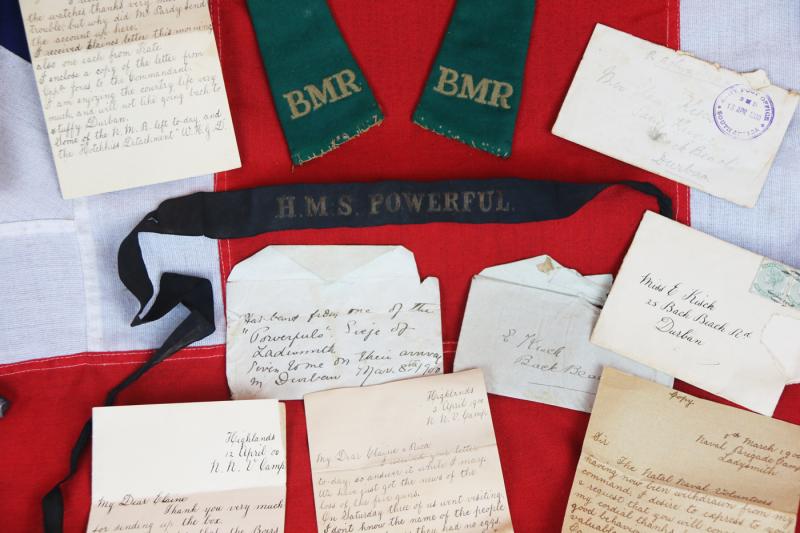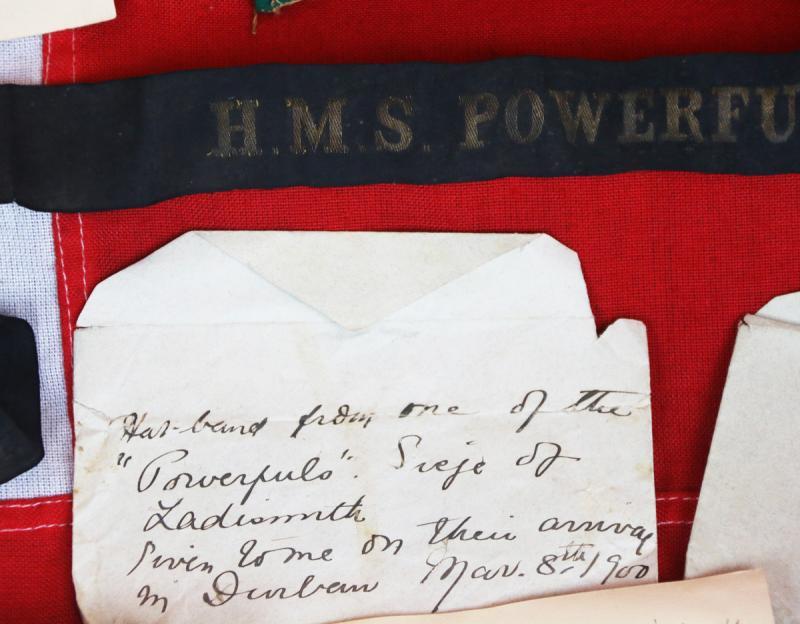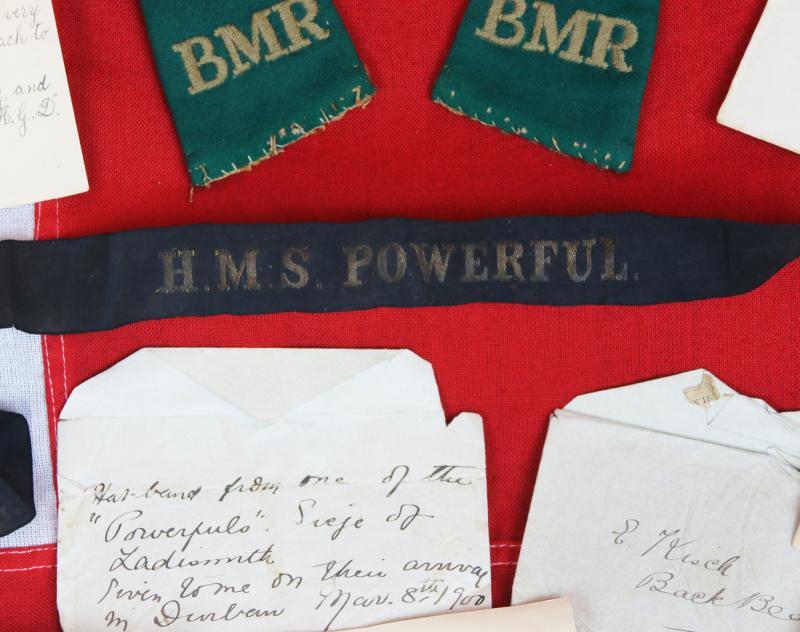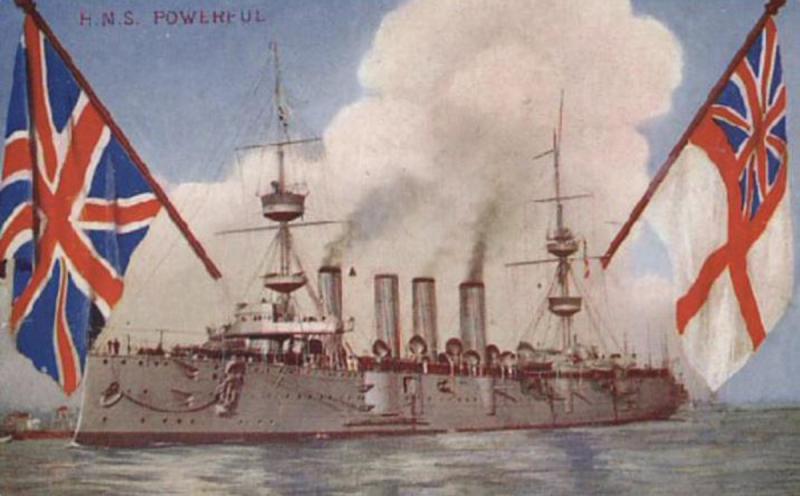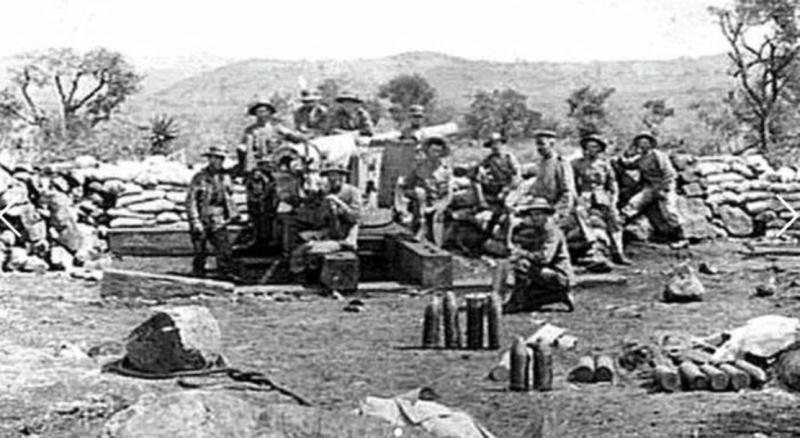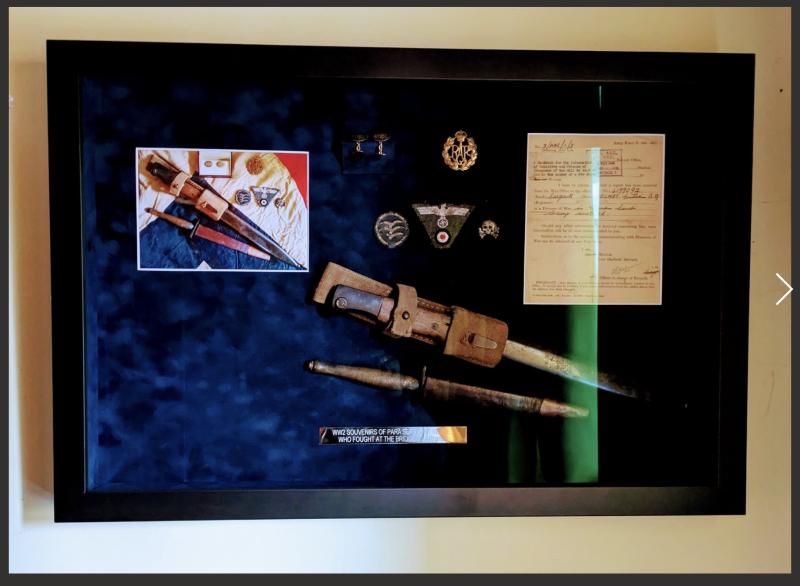An Important, Unique, & Significant, Historical Boer War Veteran's Souvenirs, the Siege of and Battle for Ladysmith Collection of A Combatant With Superb Personal Correspondence Provenance. Of Gunner Reginald Kisch, NNV One of the Besieged at Ladysmith.
Included in this fabulous collection is an HMS Powerful cap tally, with accompanying original letter, from one of the 'Powerfuls', the landing party from HMS Powerful, for the Battle for Ladysmith. A pair of uniform epaulette shoulder board’s from a combatant at the siege, The Border Mounted Rifles, pieces of shrapnel from a Long Tom the destruction of 'Puffing Billy' the British nickname of the Boers Long Tom big gun, plus numerous letters to Gunner Kisch' mother and sister, at the NNV Natal Naval Volunteers combatants home camp. Plus original newspaper cuttings of the war from the family.
The urgent transport of the cannon from HMS Powerful and HMS Terrible by the landing party, sent to the Siege of Ladysmith were the inspiration for the world renown Royal Naval Field Gun Competition at the Royal Tournament since 1907. see below
This collection would be a fabulous compliment to a medal group from the siege, such as from an HMS Powerful landing party combatant, or a NNV combatant, or a BMR combatant.
This is also the probably most historically interesting cap tally combat collection we have offered since our ‘Battle of River Plate’ German Battleship Graff Spee cap tally, taken from a killed German sailor, and personally given by Kapitan Langsdorff as a souvenir to a merchant ship captain who was a prisoner aboard his battleship. Now in a private museum collection in America.
Powerful's Naval Brigade Arrives in Ladysmith
The Powerful's Naval Brigade consisting of 283 officers and men, had arrived at the port of Durban on 29th October and travelled overnight by two trains to Ladysmith. The Brigade had with them two 4.7, four 12 pounders and four Maxim guns. The first detachment from the brigade arrived at 6am in Ladysmith in the middle of the Battle for Ladysmith. It had taken them just six days to adapt the 4.7" guns and then transport them by ship and rail to Ladysmith. Unfortunately, in the quest for speed, the Brigade did not bring sufficient ammunition. Percy Scott had asked for 5,000 rounds for the 4.7" guns but was given only 500 rounds - enough for 25 minutes of rapid firing. Departmental arguing saw to it that after Lambton had procured a further two 12 pounder guns, he was not to receive any further ammunition.
As soon as the Brigade arrived at Ladysmith Station it was under fire from the enemy. The 12 pounder guns were then transported using oxen and manpower to their positions and it was not long before they were finding their range and silencing the enemy's 'Long Tom' referred to as 'Puffing Billy' by the British. One enemy shell did dismount one of the 12 pounders and wounded three of the gun crew, the first casualties of the ship in South Africa.
It took several days for the 4.7" guns to be pulled to their positions on Junction Hill and Cove Redoubt from where they could fire on the Boers' long range guns (named Long Toms by the British). On the first day that the 4.7" guns were in action, 2 November, Lieutenant Egerton was killed by shells from Long Tom. His legs were hit by a shell bringing the response: "My cricketing days are over". His legs were amputated and by the afternoon he was cheerfully sitting up drinking champagne, but he died in the evening. On this day, the Naval Brigade's long guns were being fired on by at least five Boer guns and the town found itself finally cut off.
The Border Mounted rifles at the Siege;
the Volunteer Brigade under Colonel Royston, with Lieutenant Colonel H. T. Bru-de-Wold as Chief Staff Officer. The Naval volunteers were generally split up throughout the siege, part being on Caesar's Camp and part at Gordon Post. Between 1st November and the end of February the Natal Mounted Volunteers were frequently engaged. On 2nd November they were, with other troops, out reconnoitering; on the 3rd they were sent to cover the retirement of another force. On this occasion the Carbineers had Major Taunton and Sergeant Mapston killed, and the Border M.R. lost Captain Arnott and 11 men wounded. Section D of the defences of Ladysmith was placed under Colonel Royston. This included the thorn country north of Caesar's Camp and the Klip River Flats. Colonel Royston lost no time in building sangars and digging trenches, and soon had his section greatly strengthened. On 9th November the enemy attacked, firing 800 shells into the town; but their attack was driven off. On the 14th the Volunteers were out with Major-General Brocklehurst, and, along with the Imperial Light Horse, seized Star Hill; but it was not held permanently. When Sir Archibald Hunter made his deservedly famous sortie on 7th December to destroy the Boer guns on Gun Hill, his force consisted of 500 Natal Mounted Volunteers under Colonel Royston, 100 Imperial Light Horse (see that regiment), and a few Royal Engineers, artillerymen, and guides. The storming-parties were 100 Carbineers, Major Addison, and 100 ILH, Lieutenant Colonel Edwards. Two big guns were destroyed and one maxim brought back. Colonel Royston was among those specially mentioned in the body of the despatch. Sir George White had the ILH and Volunteers paraded on the following day, and, addressing them, said " that he did not wish to use inflated or exaggerated language, but the men of Sir Archibald Hunter's party were a credit, not only to the colony, but to the Empire. There was a lot of severe fighting to do, but it was a gratification to a General to have the help of such men."
The town and camps were during the siege constantly under shell-fire, and on 18th December one 6-inch shell bursting in the camp of the Carbineers killed 4 men, wounded 6 men, and destroyed 10 horses. The times were trying, but hard digging, sangar building, and brigade sports kept the men fairly fit. In the repulse of the great attack of 6th January 1900 the volunteers took a prominent part. The following is the report furnished by Colonel Royston to the Chief of the Staff : "I have to report that on Saturday, 6th inst., at about 4.15 am, I received information by telephone from headquarters that the enemy were making an attack on Wagon Hill. I at once despatched 80 men of the Natal MR, under Major Evans, to strengthen the outposts on the Flats, then held by 1 officer and 40 men Natal Police, attached to Volunteers, and 1 officer and 20 men Natal Carbineers. The Town Guard was also directed to stand fast at its post on the left bank of the Klip River. As it had been intimated that a battery of artillery would be placed at my disposal, I directed two squadrons Border MR, with one maxim, to accompany the guns. Major Abadie, at about 5.40 am, reported his guns in position near the point where the road to Caesar's Camp crosses the town rifle-range. On my arrival at the outpost line, at 5 am, the enemy were occupying the extreme south-eastern point of Caesar's Hill, well under cover amongst the rocks and bushes. About 50 men were visible from the Flats, but more appeared to be pushing on from the west in small parties. These men were being fired on from the thorn trees and from sangars below by my men as soon as they appeared in sight. A few minutes after my arrival the enemy advanced north along the top of the hill, firing at a party of 'Gordons' near a sangar about 500 yards to their front. I requested the officer commanding the battery to open fire, which he did with good effect, stopping the enemy's advance, and driving them into the rocks. As there appeared to be only a small party of the 'Gordons' opposed to the enemy at this spot, as far as I could see from below, I directed a squadron of Border MR, under Lieutenant Royston, to climb the hill and go to their assistance dismounted. This would be about 6 am. On my men joining the Gordons the party advanced towards the enemy in the rocks, but were at first driven back by their heavy fire, and the enemy again advanced. The battery again opened fire, and the 'Gordons' and the Border MR again advancing, drove the enemy over the point of the hill, and they never again mounted to the crest. At mid-day the enemy had retired about half way down the southern slope of the hill, but still kept up a heavy fire. Unfortunately, it was impossible to get at these with artillery fire from where the battery was limbered, owing to the danger of hitting our own people on the crest of the hill, and the officer commanding the battery did not consider it advisable, owing to the rough ground to cross, and to exposure to Bulwana, to advance any of his guns as far as our outpost line, from which point the enemy could be reached. Rifle-fire was kept up until the enemy finally got into the bed of the Fourie Spruit, where he could only be reached from the top of Caesar's Hill. A heavy fire was kept up until dark, when it gradually ceased, and the enemy appeared to be retiring up the Fourie Spruit. My casualties were 4 men killed and 2 officers and 10 men wounded. I wish to bring to notice the gallant manner in which the battery of artillery, under Major Abadie, stuck to its ground under the very heavy fire from the 6 inch gun and another long range gun on Umbulwana, and also the excellent practice made by the battery. I also consider that Lieutenant Royston, Border MR, did good service with his men. The behaviour of Captain Platt and Lieutenant Hornabrook, Vol. Med. Corps, in attending to the wounded throughout the day under heavy fire, deserves special mention; the last-named officer was wounded, besides having his clothes pierced by a bullet."
When Dundonald rode into Ladysmith on the evening of 28th February, he was accompanied by some Carbineers, Natal Mounted Rifles, Border Mounted Rifles, and Natal Police, the officers being Major D. M'Kenzie, Lieutenants Silburn, M'Kay Verney, Richards, Ashburnham, and Abraham. None of those present will ever forget this ride, probably the most memorable occasion in the lives of any of them.
The Royal Naval Field Gun Tournament;
The Interport Field Gun competition was established in 1907 and was a highlight of the Royal Tournament until the Last Run in 1999. After the demise of the Royal Tournament, the Brickwoods field gun competition was revived as a naval contest. known as the Most Dangerous Sport in the World, where losing a limb is a distinct possibility. two 18-strong teams of the Royal Navy's finest crashing around the main arena and performing a series of Formula One-style pit stops with a Victorian cannon.
Each set of kit weighs the same as a family car and each gun must be put together, taken apart and dragged up and down an 83-yard course, blasting off six shots in the process. It is all done in just over a minute. At this speed, the process can, literally, cost an arm and a leg. But there is no prize money. The teams competing for the pride of their respective bases - HM Naval Base, Portsmouth, and HMS Sultan in neighbouring Gosport. After four consecutive nights, the winning crew will receive a trophy from the Queen and, perhaps, a drink from their commanding officer.
The origins of the world famous field gun competition lie in the Second Boer War in South Africa. The legendary story tells of the siege of the British garrison in the township of Ladysmith in 1899. In support of the British Army, the Royal Navy landed guns from HMS Terrible and Powerful to help in the relief of the siege. The Naval Brigade transported guns over difficult terrain and brought them into action against the Boers.
The Royal Naval Field Gun Tournament;
The Royal Navy landed two 4.7 inch guns and four 12-pounder field guns. The guns were transported inland by rail and then drawn on makeshift carriages by oxen. For the final part of the journey, sailors from the Naval Brigade manhandled the guns over very difficult terrain. One story tells of sailors carrying one of the 12 pounder guns for 2 miles after one of the wheels collapsed.
The siege of Ladysmith lasted for 120 days until February 1900. On their return home, the sailors from the Naval Brigade paraded their guns through London and appeared at the Royal Naval and Military Tournament at the Agricultural Hall, Islington. Displays of Field Gun drill continued in subsequent years. A precursor to the competition lay in the presentation of Field Gun 'Evolutions' including one performed by Miss Weston’s Naval Boy’s Brigade from Portsmouth at the Royal Albert Hall on 21 October 1905 as part of the Centenary Commemoration of the Battle of Trafalgar.
This incredibly rare and historical collection could look incredible in a bespoke small pair, or even a set of glazed, mounted display frames. We have a company that could undertake this superbly. See photo 10 in the gallery of a perfect example of how such a display could be effected, of an original collection of combat souvenirs of an ‘Operation Market Garden’, Arnhem campaign, WW2 British ‘para’ war hero, that was completed previously for a friend and client.
If you wish to watch the Royal Naval Gun Race on youtube copy and paste link below.
https://www.youtube.com/watch?v=6lhx6Q3WuvU
Code: 24243
1495.00 GBP


